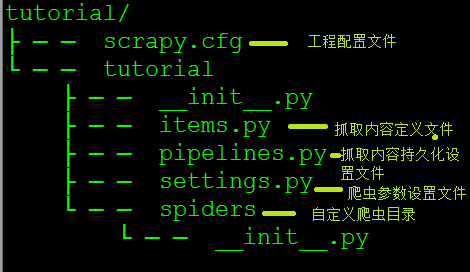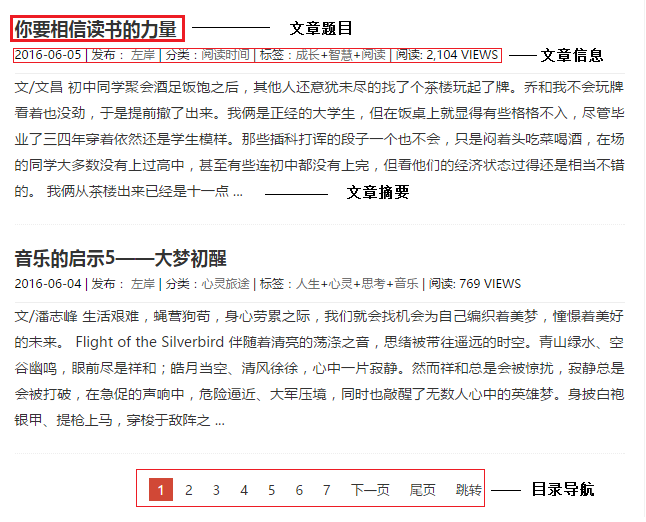Scrapy爬虫实例教程(二)---数据存入MySQL
书接上回 实例教程(一)
本文将详细描述使用scrapy爬去左岸读书所有文章并存入本地MySql数据库中,文中所有操作都是建立在scrapy已经配置完毕,并且系统中已经安装了Mysql数据库(有权限操作数据库)。
为了避免读者混淆,这里也使用tutorial作为scrapy project名称(工程的名字可以有读者自己定制)。
1. 建立tutorial工程
scrapy startproject tutorial
上述命令运行完毕后会得到tutorial(或者自定义名称)的目录,使用tree命令可以查看tutorial的目录结构,如下图所示

2. 解析左岸文章结构
左岸读书为读者提供了一些优美文章,喜欢的读者可以自行订阅(在这里提博主打广告啦[不用谢^_^])
站中所有文章都以列表的形式列出,每篇文章链接都给出了文章摘要和相应的信息(如作者,发布时间,分类信息,阅读量等信息)在列表底端给出了下一个列表的链接,具体如下图所示

点击相应的文章题目可以链接到具体的文章内容页面,读者可以自己实验试下,这里不再赘述。
3. 建立mysql数据库
建立mysql数据库 crawed
create database crawed;
use crawed;
在数据库中建立zreading数据表,这里我们要抓取文章标题,作者,文章发表日期,文章类别,文章标签,阅读量及文章内容,建立如下数据表
CREATE TABLE `zreading` (
`title` varchar(100) NOT NULL,
`author` varchar(50) NOT NULL,
`pub_date` varchar(30) DEFAULT NULL,
`types` varchar(50) DEFAULT NULL,
`tags` varchar(50) DEFAULT NULL,
`view_counts` varchar(20) DEFAULT '',
`content` text
) ENGINE=InnoDB DEFAULT CHARSET=utf8;
4. 在items.py中编写需要抓取的内容
items.py是爬虫根据用户兴趣定义爬去内容的文件,用户可以根据自己的需求,定义相应的class,爬虫在解析网页时根据解析规则生成item类对象
这里根据我们步骤3中的数据类别建立如下类:
class TutorialItem(scrapy.Item):
# define the fields for your item here like:
# name = scrapy.Field()
title = scrapy.Field()
author = scrapy.Field()
pub_date = scrapy.Field()
types = scrapy.Field()
tags = scrapy.Field()
view_count = scrapy.Field()
content = scrapy.Field()
5. 编辑pipelines.py文件
pipelines.py是设置抓取内容存储方式的文件,例如可以存储到mysql或是json文件中,读者可以根据自己实际需求选择相应的方式,本例中选择存储到mysql中。
from twisted.enterprise import adbapi
import MySQLdb
import MySQLdb.cursors
from scrapy.crawler import Settings as settings
class TutorialPipeline(object): def __init__(self): dbargs = dict(
host = 'your host' ,
db = 'crawed',
user = 'user_name', #replace with you user name
passwd = 'user_password', # replace with you password
charset = 'utf8',
cursorclass = MySQLdb.cursors.DictCursor,
use_unicode = True,
)
self.dbpool = adbapi.ConnectionPool('MySQLdb',**dbargs) '''
The default pipeline invoke function
'''
def process_item(self, item,spider):
res = self.dbpool.runInteraction(self.insert_into_table,item)
return item def insert_into_table(self,conn,item):
conn.execute('insert into zreading(title,author,pub_date,types,tags,view_counts,content) values(%s,%s,%s,%s,%s,%s,%s)', (item['title'],item['author'],item['pub_date'],item['types'],item['tags'],item['view_count'],item['content']))
6. 在settings.py中设置pipeline
当使用pipeline保存抓取内容时,需要设置相应的pipeline类,以便让系统知道根据什么方式进行存储,在settings.py中加入一下代码
ITEM_PIPELINES = {
'tutorial.pipelines.TutorialPipeline': 300,
}
7. 解析网页,抓取需要内容
经过以上6步,所有的配置的工作已经结束,接下来,我们的重点就是如何从网页中解析出我们所需要的内容,在解析过程中需要借助一些开发插件,比如firefox的firebug,chrome的开发者工具,本例中使用chrome的开发工具。
在这一步我们需要编写网页解析的具体逻辑-如何处理网页,得到我们所需的内容。在spiders目录下,新建zreading.py文件,然后定义zreadingCrawl爬虫(继承scrapy的BaseSpider即可)
class zreadingCrawl(BaseSpider):
name = "zreading" # the name of spider
allowed_domain = ['zreading.cn'] # allowed domain for spiders
start_urls = [
'http://www.zreading.cn' #the start url / the entrance of spider
]
具体的解析过程如下:
a. 首先解析左岸的文章列表,使用chrome的开发者工具,在文章标题处右击,点击检查,然后复制为xpath路径。在解析网页是就可以根据这个路径定位到你所需的内容,这里我们只是想获得文章的连接,所有我们只需要提取文章题目链接的
href属性值即可,在文章目录页中,有两种我们需要的链接,一种是文章内容的链接,另一种则是文章列表的下一页,对于文章内容链接我们可以直接请求响应的URL,然后解析内容即可;而对于目录链接则可以从头解析(也即请求目录页然后进一步解析)。
由上述可知,这是一个不断循环的过程,直至没有下一页为止。
b. 在解析的过程中,对于每次的解析内容,都需要进行处理,如在提取标题时,得到的内容前后包括很多空格,而且为了避免在数据库出现乱码,所有数据都编码成utf8。这里我们需要编写
c. 具体代码如下(在zreadingCrawl中添加如下函数):
def parse(self,response):
if response.url.endswith('html'):
item = self.parsePaperContent(response)
else:
# get all the page links in list Page
sel = Selector(response)
links = sel.xpath('//*[@id="content"]/article/header/h2/a/@href').extract()
for link in links:
yield Request(link,callback=self.parse)
# get the next page to visitr
next_pages = sel.xpath('//*[@id="content"]/div/a[@class="next"]/@href').extract()
if len(next_pages) != 0:
yield Request(next_pages[0],callback=self.parse)
# record the list page
yield item
def parsePaperContent(self,response):
print "In parsse paper content function......"
# get the page number '5412.html'
# page_id = response.url.split('/')[-1].split('.')[0] ----- OK
r =re.match(r'\d+',response.url.split('/')[-1])
page_id = r.group()
# instantie the item
zding = TutorialItem()
sel = Selector(response)
#add tilte
title = sel.xpath("//div[@id='content']/article/header/h2/text()").extract()[0]
s_title = title.encode("utf-8")
zding['title'] = s_title.lstrip().rstrip() #add pub_date
pub_date = sel.xpath('//*[@id="'+page_id+'"]/div[2]/span[1]/text()').extract()[0]
s_pub_date = pub_date.encode("utf8")
zding['pub_date'] = s_pub_date.lstrip().rstrip() #add author
author = sel.xpath('//*[@id="'+page_id+'"]/div[2]/span[2]/a/text()').extract()[0]
s_author = author.encode("utf8")
zding['author'] = s_author.lstrip().rstrip() #add tags including type and paper tags tags = sel.xpath('//*[@id="'+page_id+'"]/div[2]/a/text()').extract()
tags = [s.encode('utf8') for s in tags]
zding['types'] = tags[0]
zding['tags'] = "+".join(tags[1:]) #add view count
views = sel.xpath('//*[@id="'+page_id+'"]/div[2]/span[3]/text()').extract()[0]
r = re.search(r'\d+',views)
view_count = int(r.group())
zding['view_count'] = view_count
#add content
content = sel.xpath('//*[@id="'+page_id+'"]/div[3]/p/text()').extract()
zding['content'] = "\n".join(content) #return the item
return zding
8. 在命令行下运行
scrapy crawl zreading
在屏幕中会闪解析过的网页和解析得到的item,等运行完毕后查看数据库中的zreading表的内容,这里因为文章较长,不再单独贴图。
*****声明:本帖纯粹是个人兴趣爱好,绝无其他任何恶意。本人很喜欢看左岸的文章,恰逢学习scrapy,就以此为例。在此声明,本帖只是技术解析,绝无转载。*****
最新文章
- MyBatis Cache配置
- MongoDB JAVA API Filters
- QQ互联登录 微博登录问题
- 【JavaScript】常用方法
- 他们在军训,我在搞OI(三)
- dedecms 按照栏目指定的id排序
- Echache整合Spring缓存实例讲解(转)
- cookie解决跨域问题
- 查找修补文件差异diff、patch
- Codeforces Round 1153(div. 2)
- WPF TextBlock IsTextTrimmed 判断文本是否超出
- nginx安装ngx_lua_waf防护
- XGBoost介绍
- npm使用国内淘宝镜像的方法
- js两种打开新窗口
- Hackerank-Array-NewYearChaos
- Python3 文件读写r,w,a
- 利用C#查看特定服务是否安装
- 洛谷 P2501 [HAOI2006]数字序列 解题报告
- python os模块练习题